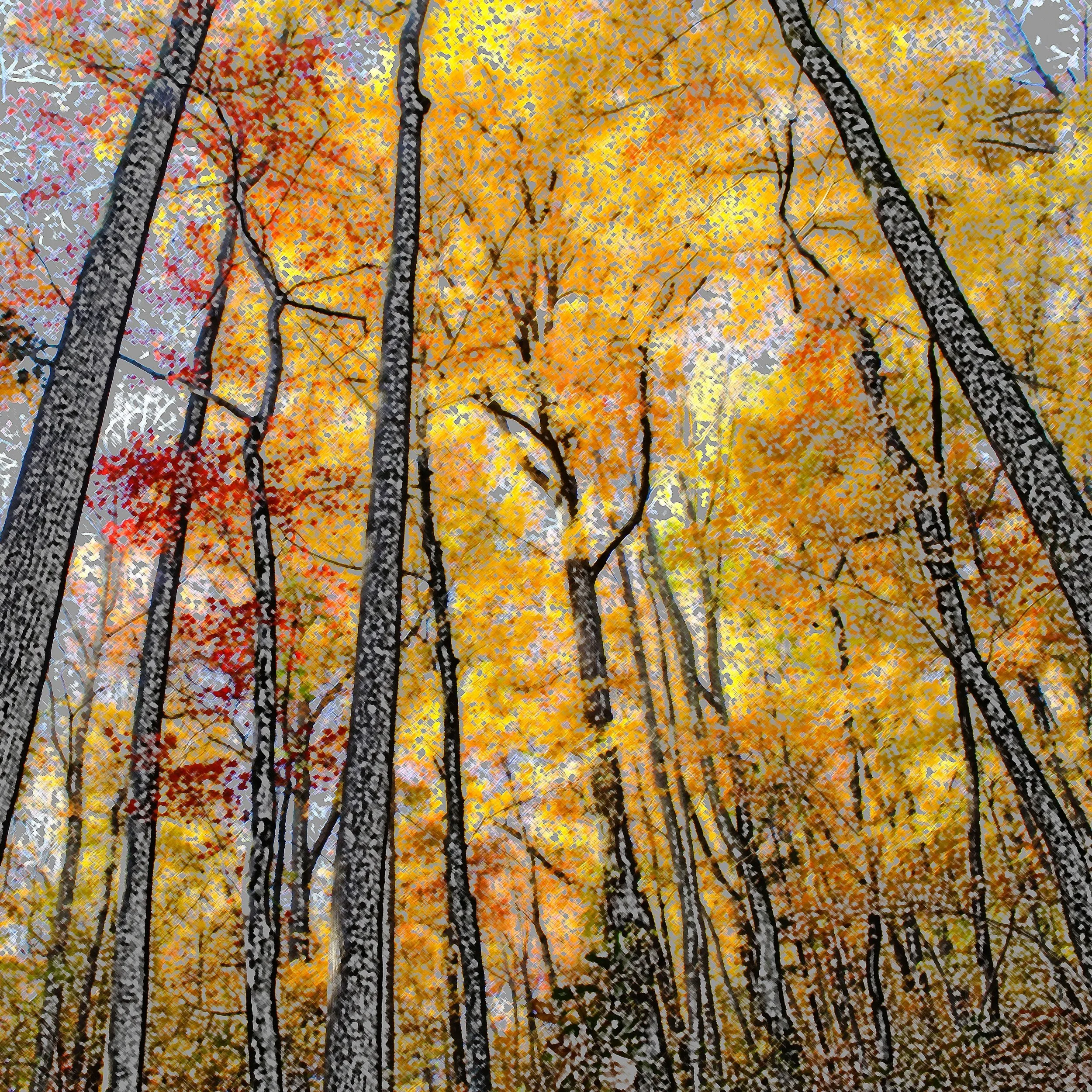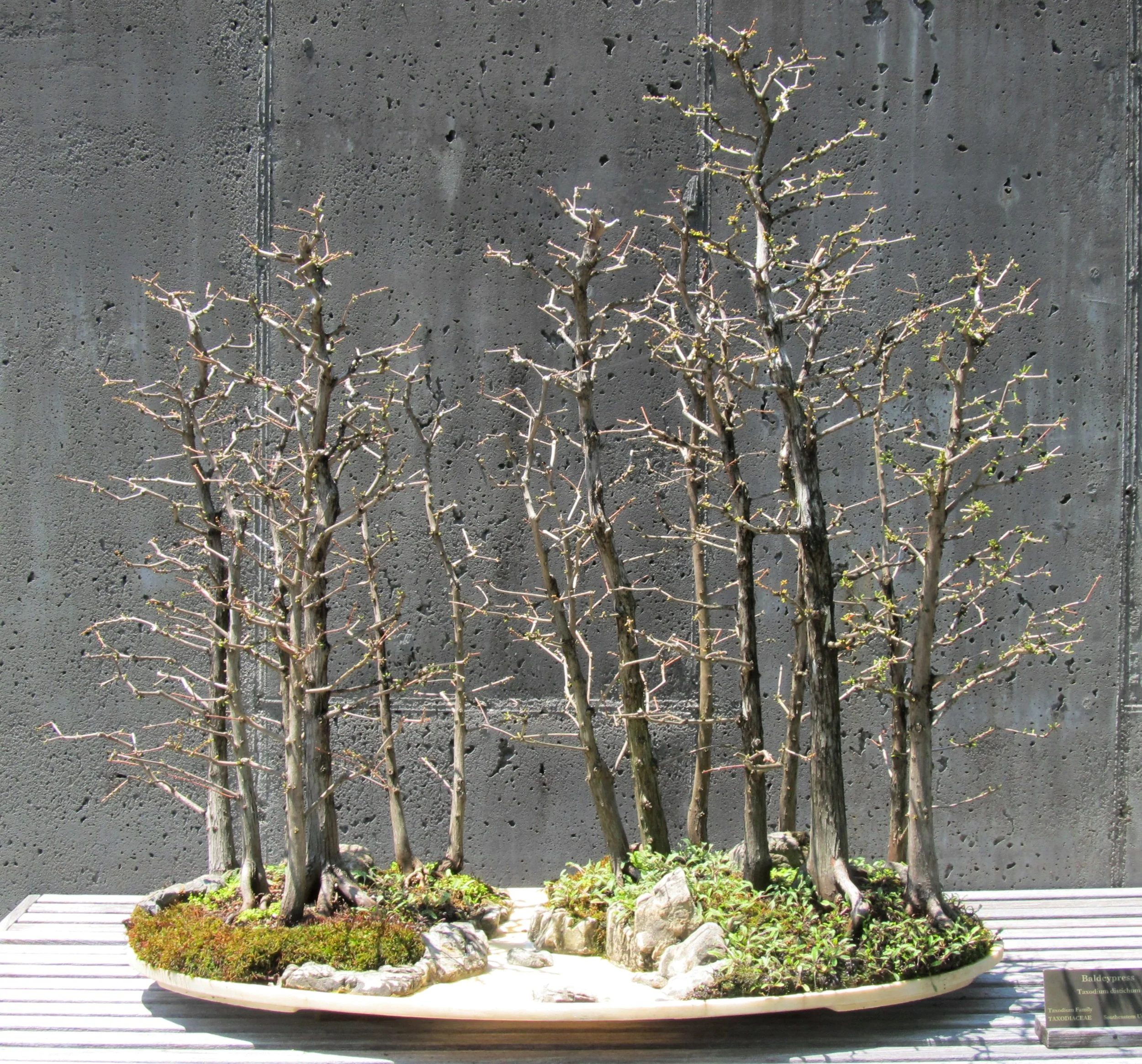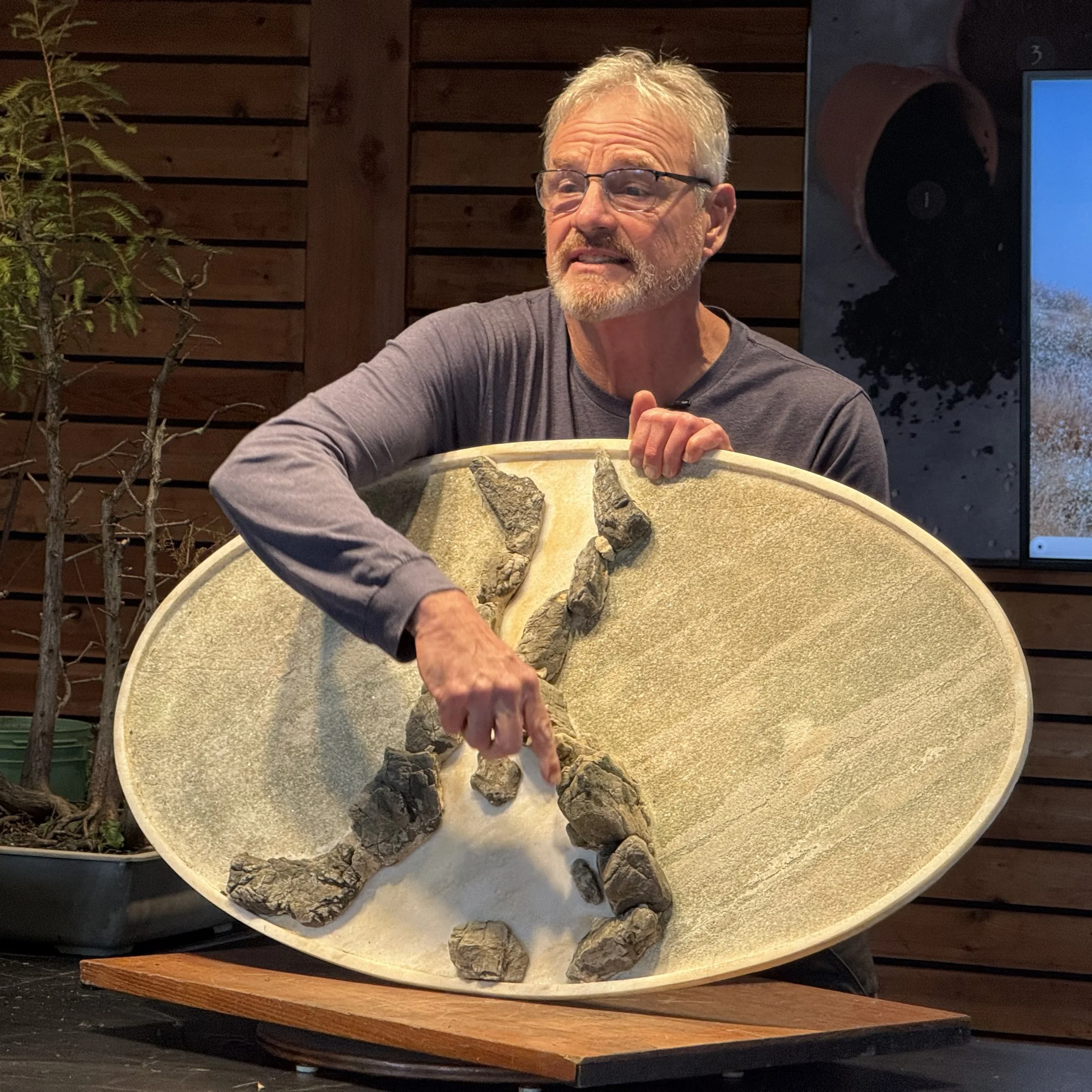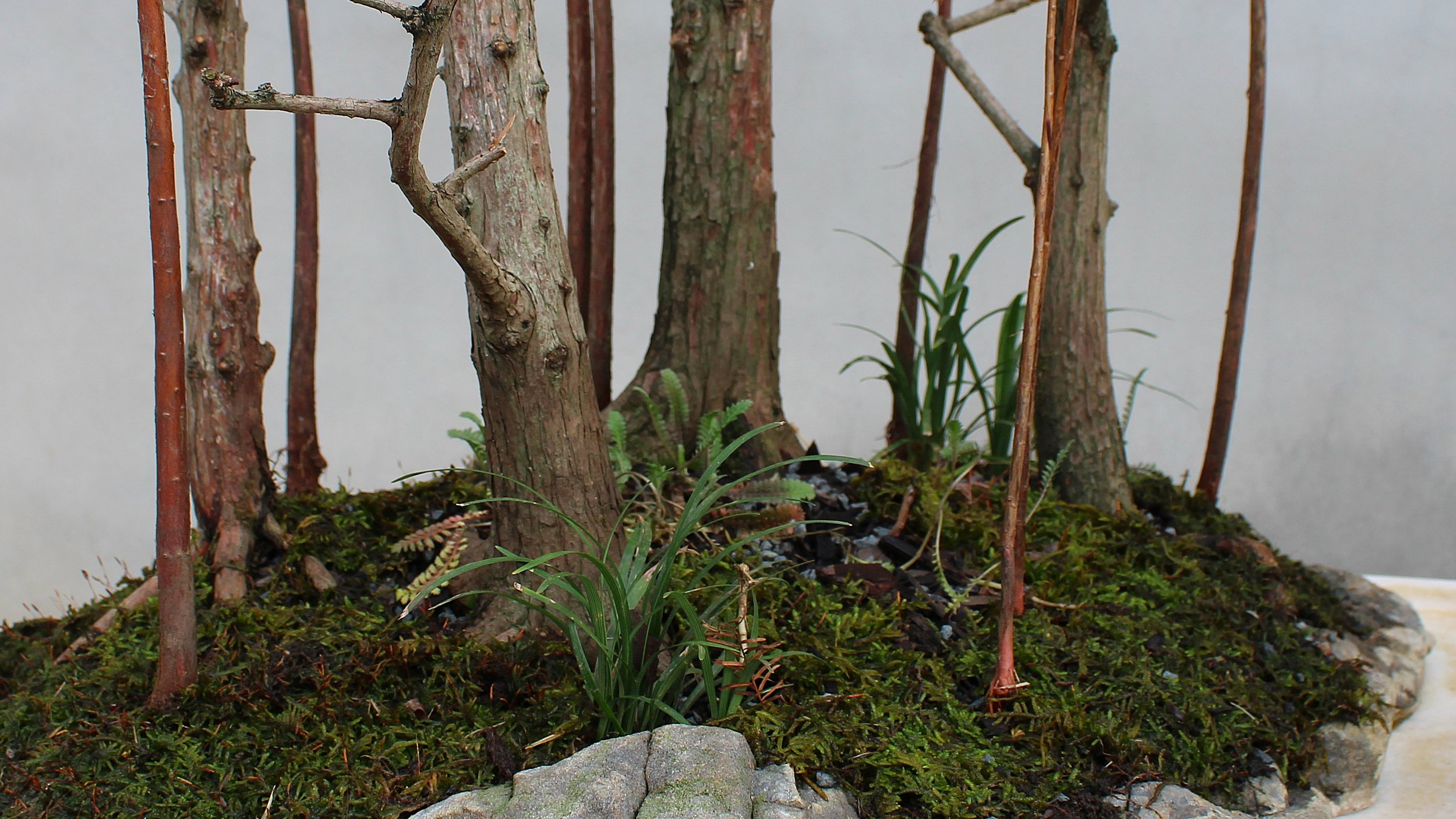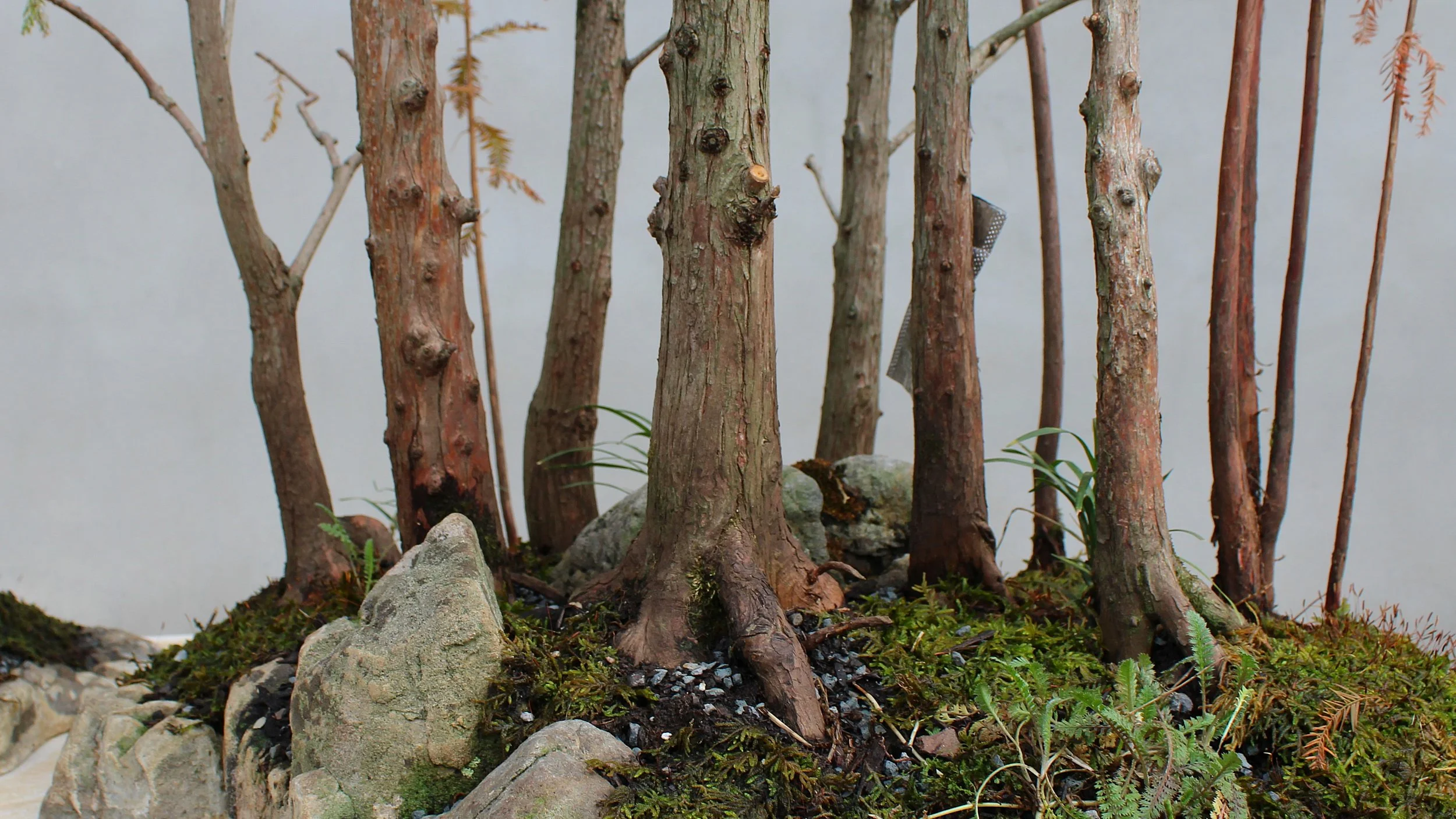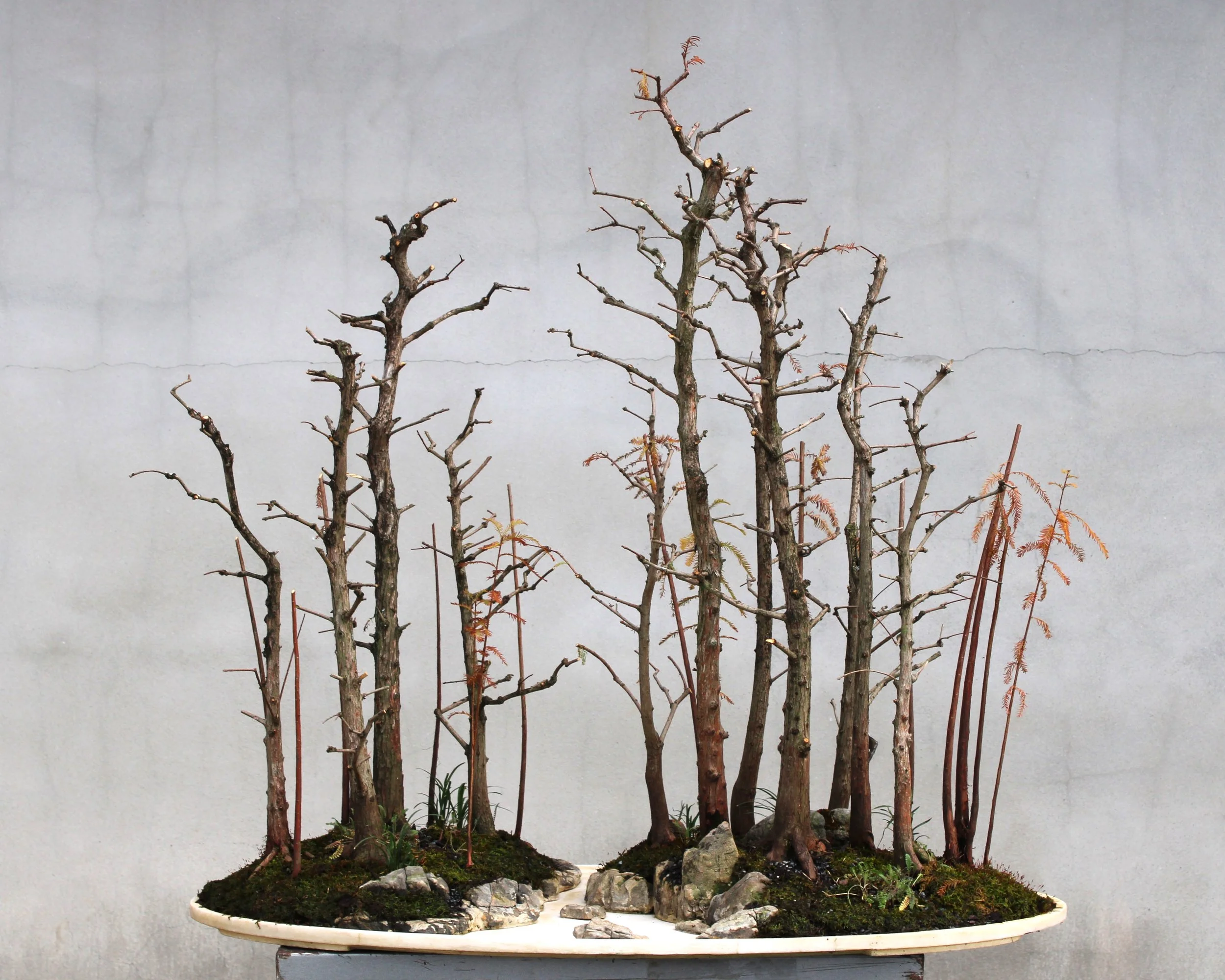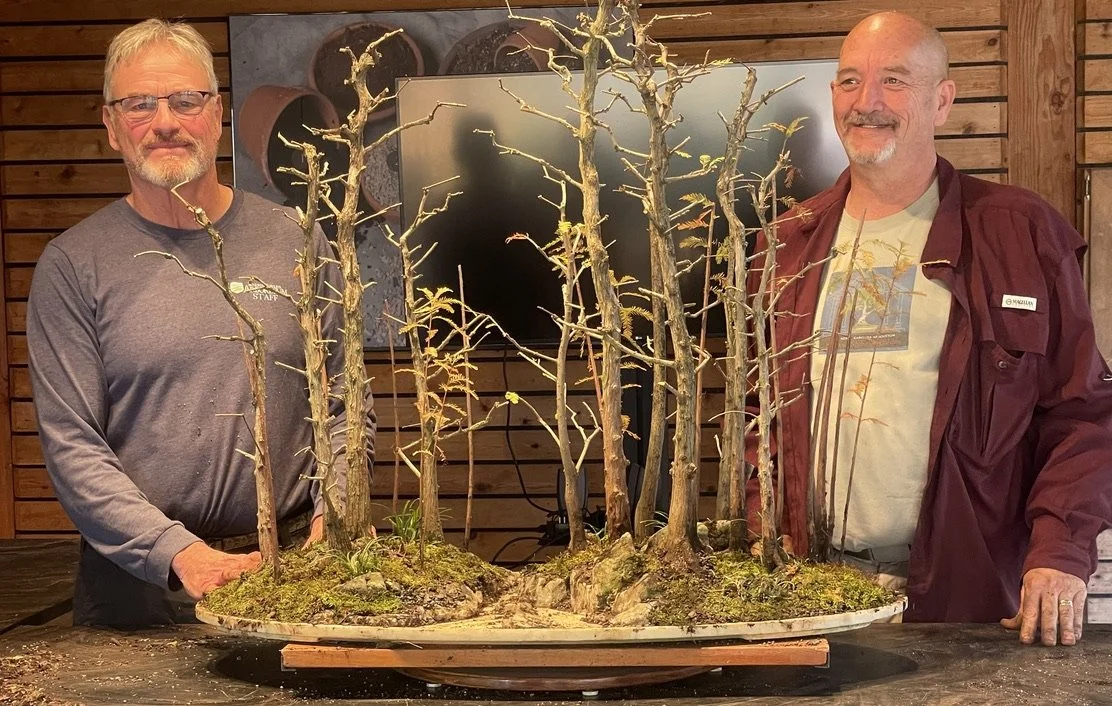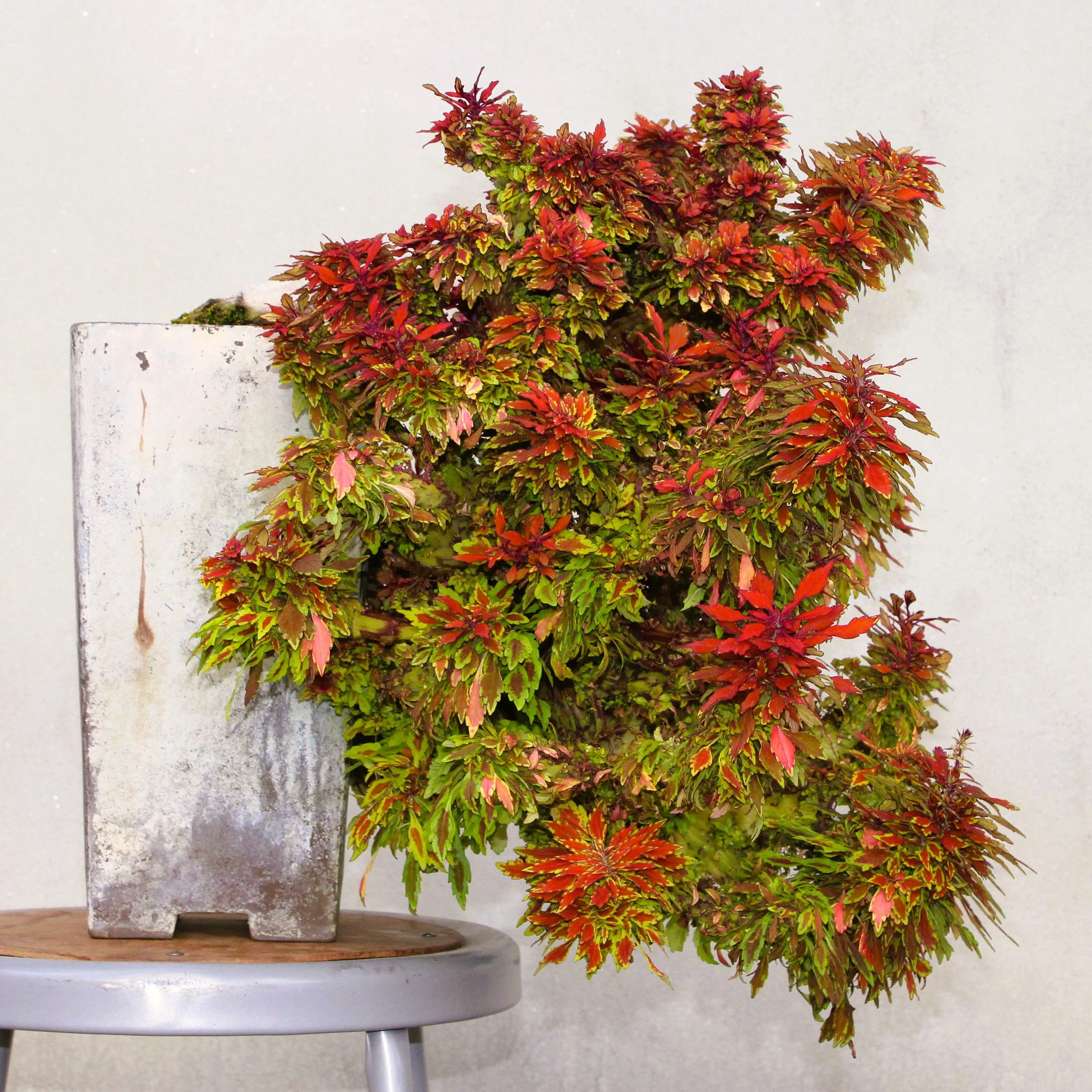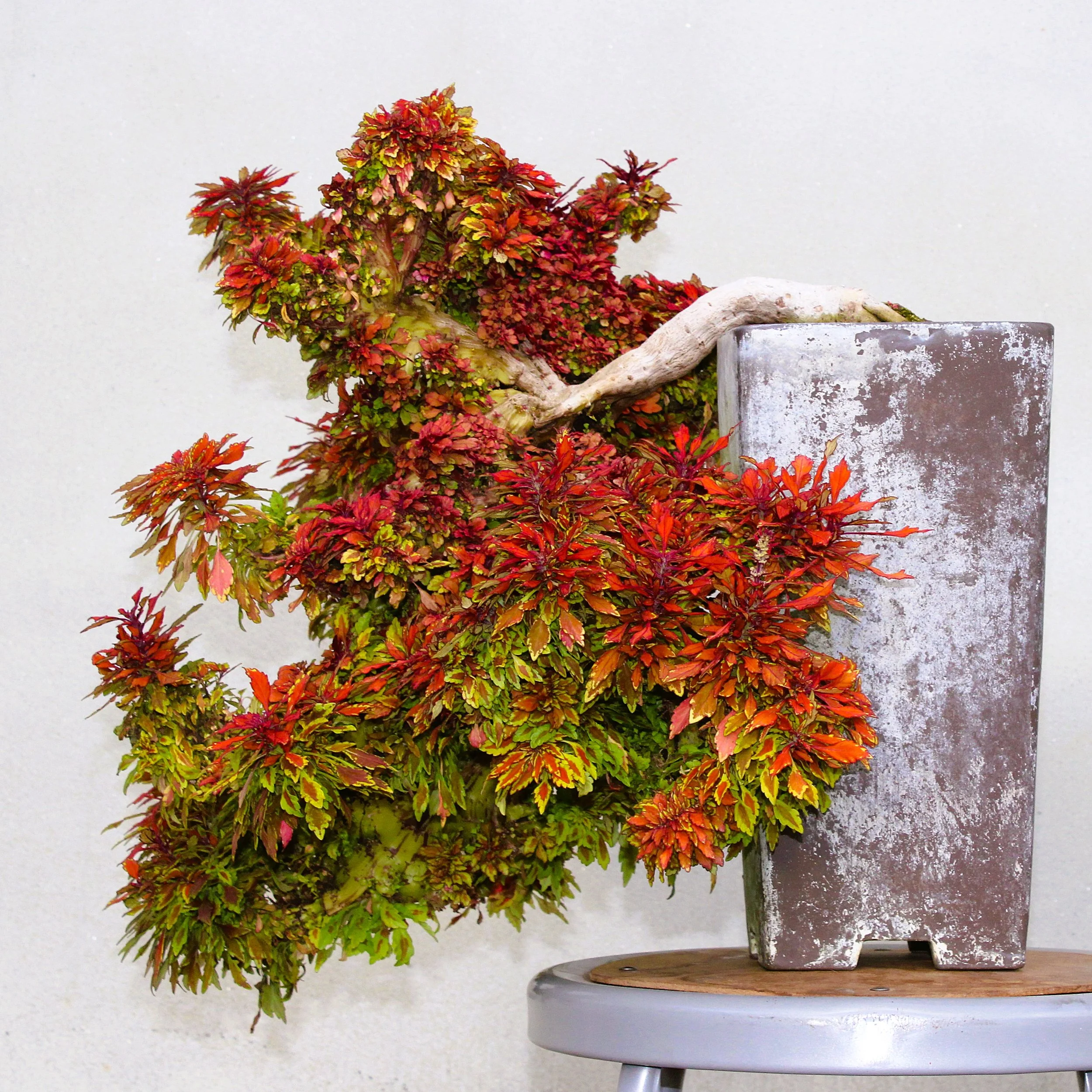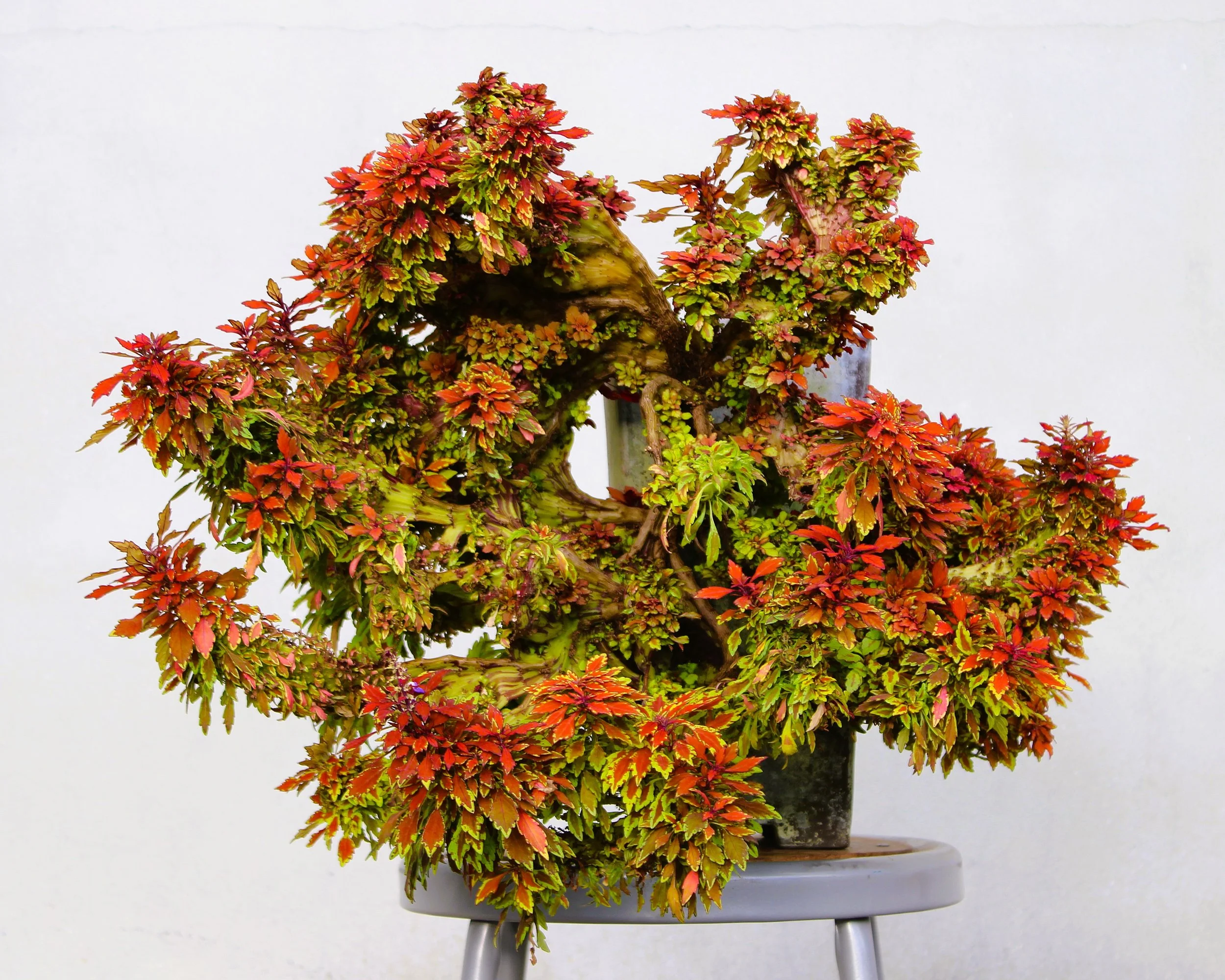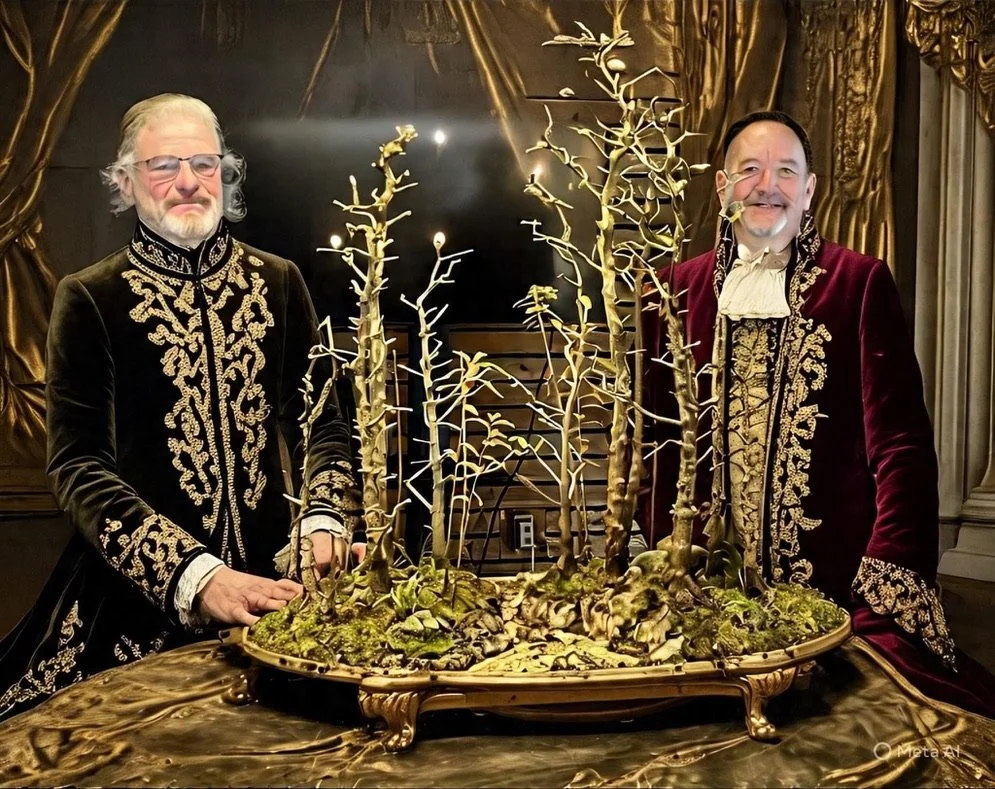Water-and-Land Redux
Penjing artist Qingquan Zhao's water-and-land baldcypress tray landscape planting was a favorite piece in the Arboretum's bonsai collection for a long time. Unfortunately and unexpectedly, this planting lost its main tree in 2020 and had to be decommissioned, its leftover parts disassembled and carried on in a mostly neglected state for the next five years. These remaining components were recently reassembled on the same white marble slab that housed the original composition, resulting in a new arrangement that is reminiscent of what Mr. Zhao created. The similarity is intentional. The new landscape is meant to evoke the original while avoiding any conscious attempt to recreate it.
Mr. Zhao’s original baldcypress water-and-land planting, as seen on display in 2019.
The work of building this new composition was done as a public demonstration in the pavilion of the Bonsai Exhibition Garden, in front of a sizable crowd of interested onlookers. The program was conducted in honor of the twentieth anniversary of the garden's opening in October of 2005. It was good luck that my friend John Geanangel decided to come to Asheville that day for our little garden celebration, and once I knew he'd be there I asked him to join me in the demonstration program and he agreed. In retrospect, if I had undertaken the project without a second pair of hands it would not likely have gone so well. There was too much work to be done.
I should hasten to acknowledge that John provided more than just a second pair of hands. He happens to be one of the most experienced people you will find in the field of baldcypress bonsai. Not only that, but he's a polished public presenter and he and I have a long history of doing bonsai demonstrations together. Working onstage with John felt like old times to me, and his easy way of communicating with an audience helped keep the people in the seats entertained and informed. John and I have a similar perspective on bonsai that allows us to share in the creation of a piece without bumping into each other too often. I think of the new version of the water-and-land baldcypress tray landscape as a collaborative piece, infused with a lot of John's positive influence.
Photos by David Lewis
John Geanangel
Even after a prolonged meditation on how to go about rebuilding this landscape (as documented in the previous three Journal installments), at the start of the demonstration I still didn't have a clear vision of how the composition would come together. I had a vague idea of what might happen, but that little bit of a clue proved to be incorrect. I imagined the new planting would be more open than the original. I thought there would be fewer trees involved, as the previous version of the landscape had become too crowded over time. There were sixteen trees used in Mr. Zhao's landscape, and to my disbelief upon counting them at the end, the new version is comprised of twenty seven. Sixteen of those twenty seven trees are very young, however — one, two and three year seedlings that are the diameter of a pencil or less.
It was perhaps inevitable that the new composition would mirror the original one. The large, oval, white marble slab still features the rocks that Mr. Zhao carefully arranged and cemented in place to form a pattern suggestive of a streambed. He artfully situated the stream off-center, and in so doing created two unequal planting zones on either side. I could see no value in disassembling any of that. Given that the format would be exactly the same and at least some of the same trees would be redeployed, the new composition would have had to have been a radical departure to not evoke the previous iteration. A bold new look was never the objective. I was, however, determined to not attempt a conscious recreation of Mr. Zhao's work.
Photo by Felix Laughlin
The trees salvaged from the original landscape had remained together, planted in two large pots. What had been one side of the stream was planted in one pot and the other side of the stream in the other. As had been anticipated, in two instances clumps of trees were left intact. The secondary, or smaller, side of the arrangement originally consisted of seven trees. Four of those were reused and they remained together in the same configuration Mr. Zhao gave them twenty seven years ago. That group of four was replanted on the same side of the stream they originally occupied, but in a different orientation. Eight seedlings were added to fill out that portion of the planting.
Left side detail
Seven trees from the primary portion of the planting on the right hand side of the stream made it back into the new planting. There had been nine trees originally, including the main tree that died. Three of these original trees remained together as they were and were utilized as a clump. Four others were separated and placed individually in the new arrangement on the right side of the stream. Those were augmented by an additional eight seedlings.
Right side detail
The big issue, and again this had been anticipated, was dealing with the lack of a noticeably larger tree to serve as the focal point of the new composition. I had entertained the idea of selecting one larger tree from three remaining original trees that were all about the same in terms of visual weight, and then not using the other two. When figuring it out on the ground, however, it didn't seem that was a viable solution. The loss of those two larger trees would have diminished the overall effect of the grouping to an unacceptable degree. The solution turned out to be ignoring the convention of having one noticeably larger tree to be the focal point in a group planting composition.
The main tree convention is just that in the end — a convention. It's the way things are usually done. It's a technique that pretty reliably works, but it's not the only possibility. As I see it, a good composition needs a focal point in order to facilitate the viewer experience by letting them know where to begin the visual journey. The eye lands there first then moves throughout the rest of the arrangement. A noticeably larger tree in a grouping of trees makes a natural focal point, but orientation of the viewer's eye can be achieved by other means.
In this tray landscape, the larger portion of "land" on the right side of the stream already acts as a magnet for the viewer's attention, as does the larger grouping of trees found there. Greater mass typically translates to greater visual weight. Accentuating that, two of the largest three trees are in close proximity to each other within that larger grouping, and a third substantial tree is located nearby behind them. Seen from the primary viewing angle that third tree appears between the other two, slanting so as to visually join them. This amalgamation of three trees is then further enhanced by being anchored to the largest rocks used to delineate the suggested stream. By "anchored" I mean to suggest that the trees and rocks appear so close to each other that they might be visually read as linked together. In addition, one of the two bigger trees has the largest base of any of the trees in the entire planting and the other tree is the tallest. Ideally, both of these features would be found on the same tree. In this instance, fortunately, the distance from the base of the trees to their apexes is long enough to obscure the fact that the tallest tree does not have the widest base.
This might seem like after-the-fact rationalization, but John and I had a good idea of what we were doing. The big question is — does it work? I think it does. I think when people encounter this tray landscape their eyes will be drawn first to the desired place within the composition, before moving on to explore the rest of it.
The preferred view of the new baldcypress water-and-land planting, created in demonstration 10/25/25.
The other big question is this: How does the new iteration compare with Mr. Zhao's original baldcypress water-and-land planting? Other people will be the judge of that. For me, it is not a competition between the old and the new because the two cannot be presented side by side on equal terms. The old had a good run then came to an end. The new is derived from the old and carries forward the remains of what was. But the new landscape is only at its beginning, and time will work on it and hopefully improve it. With any luck it has a long way to go.
Right side view
Left side view
Back side view
A view from the stream
Photo by Cindy Geanangel
Mr. Zhao’s version of the planting, photographed in 2005 — seven years after being assembled.
The new water-and-land planting, three days after the demonstration in which it was made.
Because this entry is being posted on Halloween, here are some images of a “monstrous” planting. The subject is a mutated form of Fancy Feathers Copper Coleus (Coleus scutellarioides ‘Copper’). The mutation is technically known as fasciation, in which parts of the plant grow abnormally resulting in a strange but sometimes appealing appearance. It’s an “eye of the beholder” sort of thing:
Also in honor of Halloween, the following image was shared by a person who attended the demonstration program. Make of it what you will…
